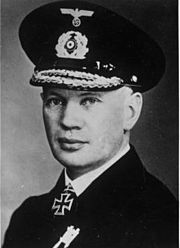| Oskar Kummetz | |
|---|---|
 | |
| Born | 21 July 1891 |
| Died | 17 December 1980 (aged 89) |
| Place of birth | Illowo in the district of Neidenburg, East Prussia |
| Place of death | Neustadt an der Weinstraße |
| Allegiance |
|
| Service/branch |
|
| Years of service | 1910–1945 |
| Rank | Generaladmiral |
| Unit | SMS Victoria Louise |
| Commands held | Kampfgruppe "Oslo" |
| Battles/wars | |
| Awards | Knight's Cross of the Iron Cross |
Oskar Kummetz (21 July 1891 – 17 December 1980) was a Generaladmiral with the Kriegsmarine during World War II. He also served in the Kaiserliche Marine during World War I. Kummetz was awarded the Knight's Cross of the Iron Cross (German language: Ritterkreuz des Eisernen Kreuzes) for his actions in the Battle of Drøbak Sound, during which his command, the Blücher was hit in the superstructure by two 28 cm shells from Norwegian fortress Oscarsborg, 15 cm shells from Kopås fortress and 5,7 cm gunfire from Husvik fortress. From Kaholmen "Blücher" was hit by two torpedoes and she sank to 84 meters between the sound. The Knight's Cross of the Iron Cross was awarded to recognise extreme battlefield bravery or successful military leadership. His next command, the Admiral Hipper unsuccessfully attacked a British convoy during the Battle of the Barents Sea, and the Hipper was damaged by British cruisers, while his escort, the Z16 Friedrich Eckoldt was sunk with all hands by HMS Sheffield (C24).
Awards
- Iron Cross (1914)
- Honour Cross for Combatants (January 1935)[1]
- Wehrmacht Long Service Award 1st to 4th Class (2 October 1936)[1]
- Magyar Köztársasági Érdemrend (Commander of the Hungarian Order of Merit) (20 August 1938)[1]
- Clasp to the Iron Cross (1939)
- Memel Medal (14 March 1940)[1]
- High Seas Fleet Badge (5 February 1942)[1]
- Knight's Cross of the Iron Cross on 18 January 1941 as Konteradmiral and leader of the Kampfgruppe Oslo[2]
References
- Citations
- Bibliography
- Dörr, Manfred (1995). Die Ritterkreuzträger der Überwasserstreitkräfte der Kriegsmarine, Band 1: A-K (in German). Osnabrück, Germany: Biblio Verlag. ISBN 3-7648-2453-0.
- Fellgiebel, Walther-Peer (2000) (in German). Die Träger des Ritterkreuzes des Eisernen Kreuzes 1939–1945 – Die Inhaber der höchsten Auszeichnung des Zweiten Weltkrieges aller Wehrmachtsteile [The Bearers of the Knight's Cross of the Iron Cross 1939–1945 — The Owners of the Highest Award of the Second World War of all Wehrmacht Branches]. Friedberg, Germany: Podzun-Pallas. ISBN 978-3-7909-0284-6.
- Range, Clemens (1974). Die Ritterkreuzträger der Kriegsmarine [The Knight's Cross Bearers of the Navy]. Stuttgart, Germany: Motorbuch Verlag. ISBN 978-3-87943-355-1.
- Scherzer, Veit (2007) (in German). Die Ritterkreuzträger 1939–1945 Die Inhaber des Ritterkreuzes des Eisernen Kreuzes 1939 von Heer, Luftwaffe, Kriegsmarine, Waffen-SS, Volkssturm sowie mit Deutschland verbündeter Streitkräfte nach den Unterlagen des Bundesarchives [The Knight's Cross Bearers 1939–1945 The Holders of the Knight's Cross of the Iron Cross 1939 by Army, Air Force, Navy, Waffen-SS, Volkssturm and Allied Forces with Germany According to the Documents of the Federal Archives]. Jena, Germany: Scherzers Miltaer-Verlag. ISBN 978-3-938845-17-2.
| |||||||||||||||||||||||||||||||||||||||||||||||||||||||||||||||||||||||
The original article can be found at Oskar Kummetz and the edit history here.
